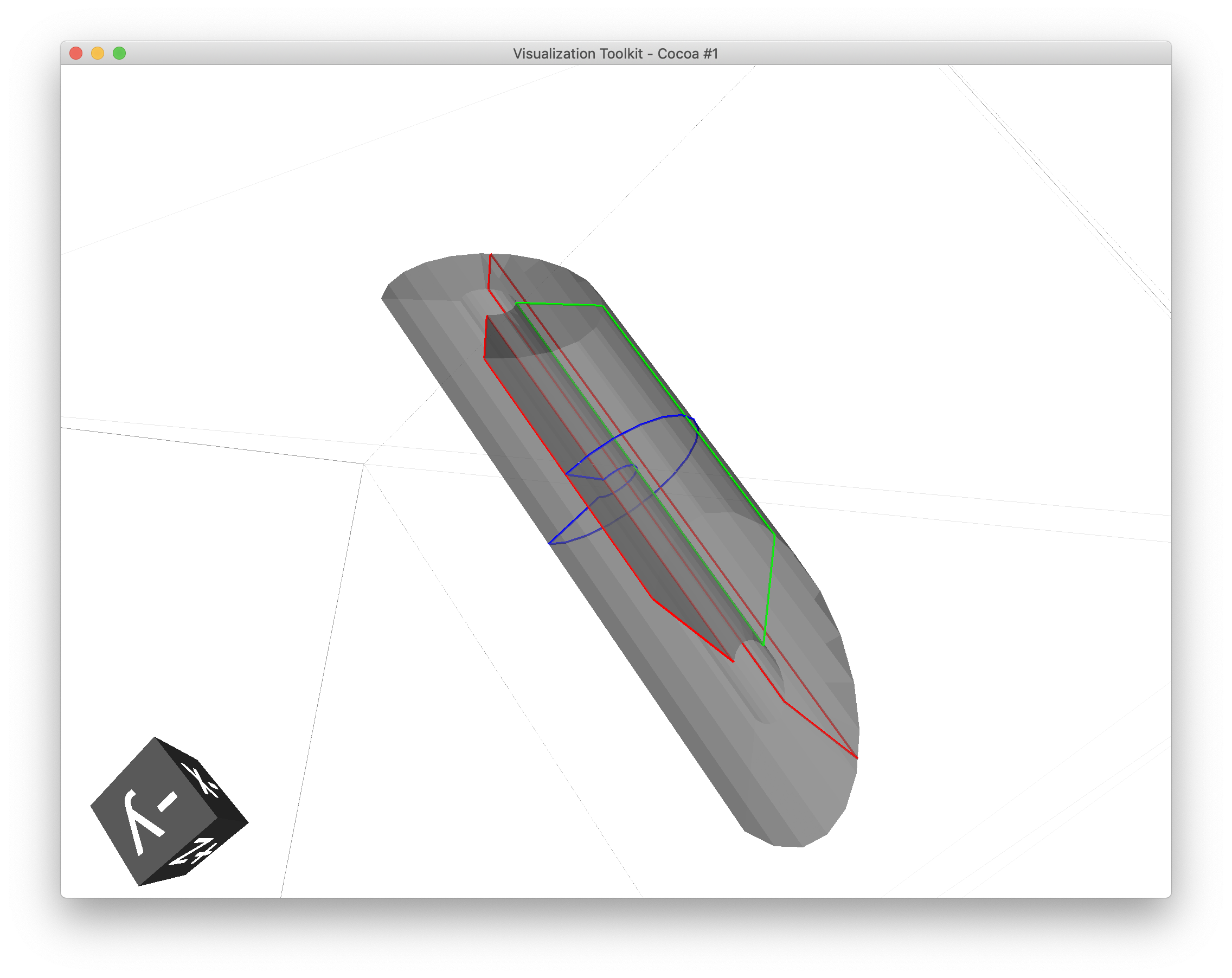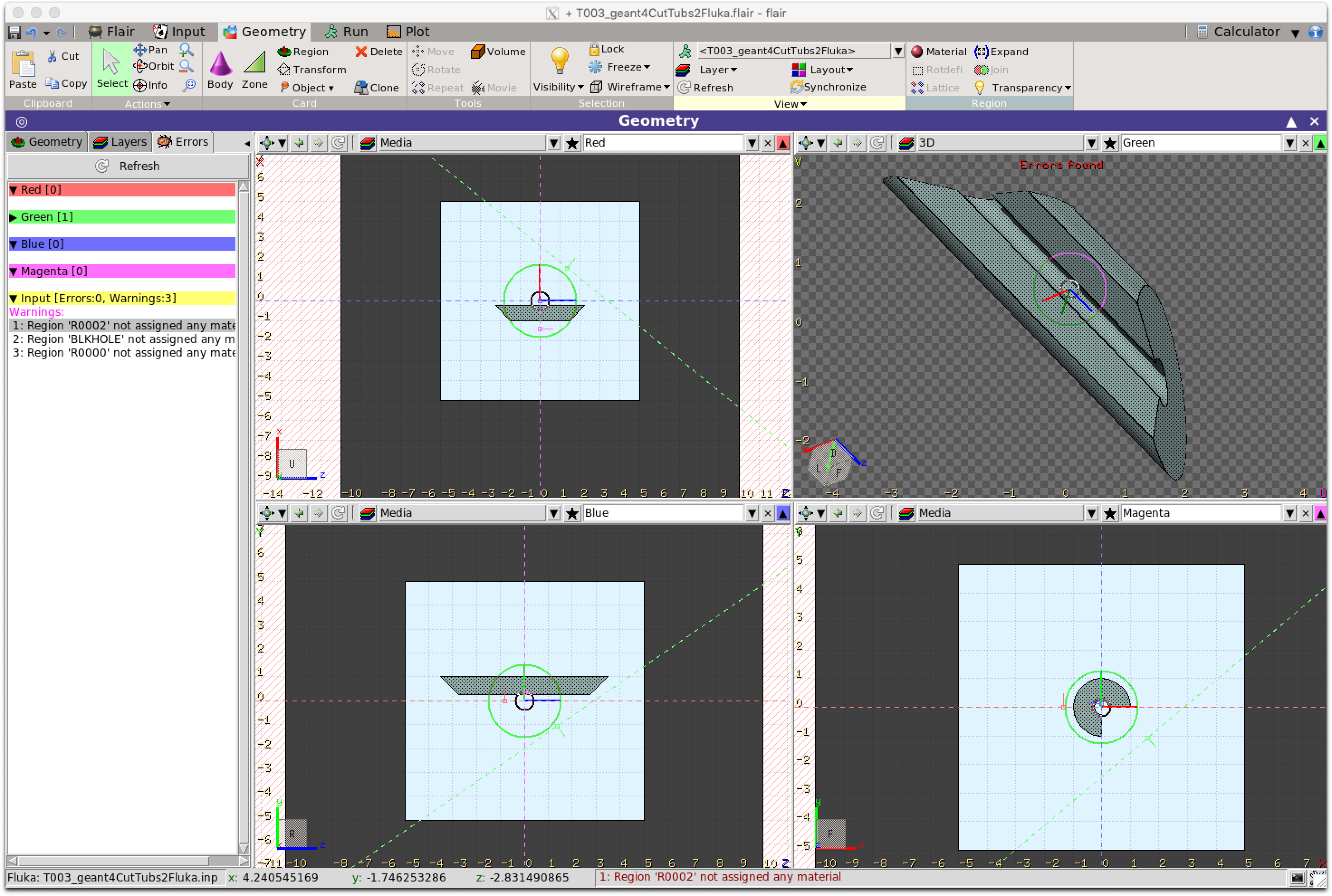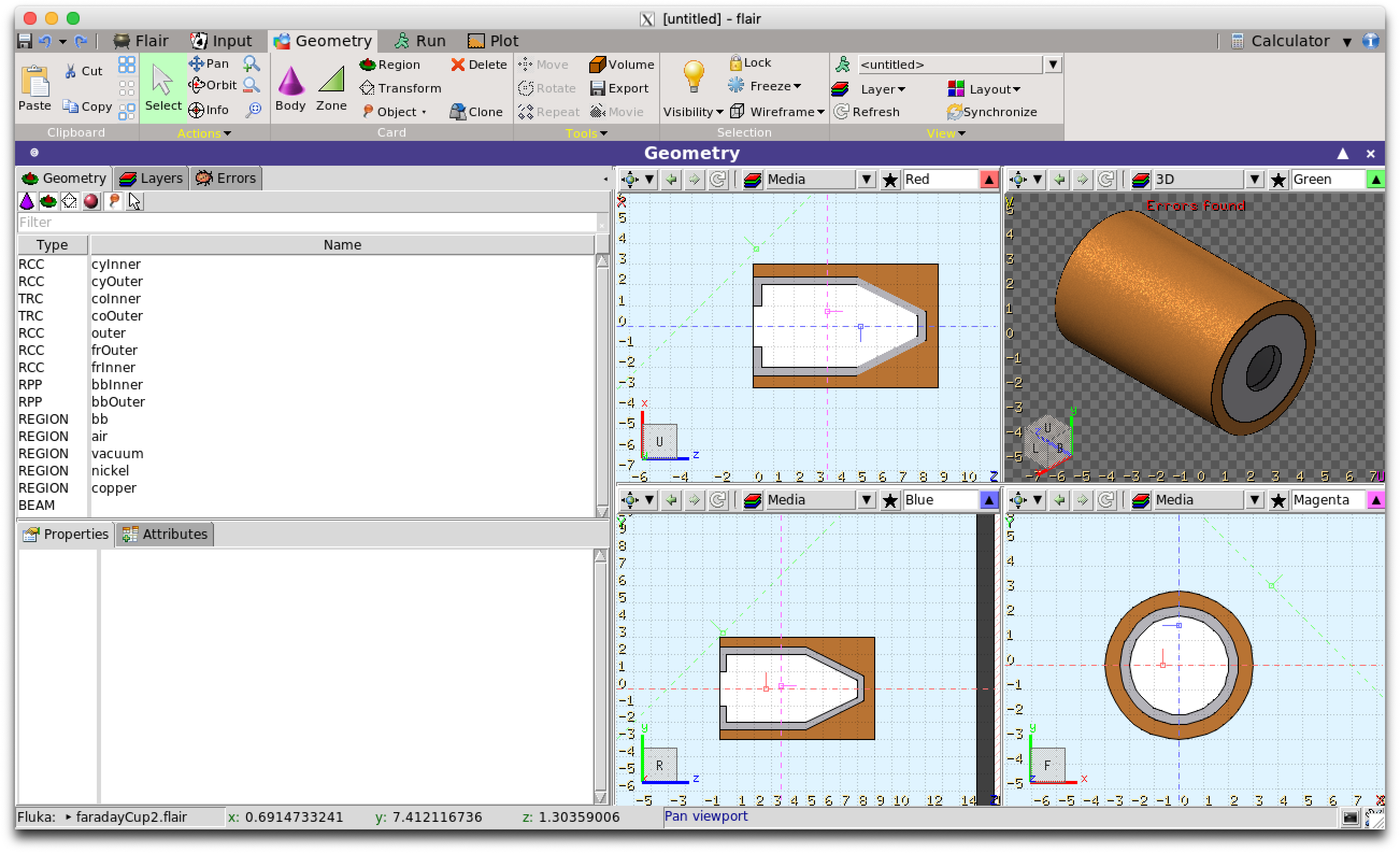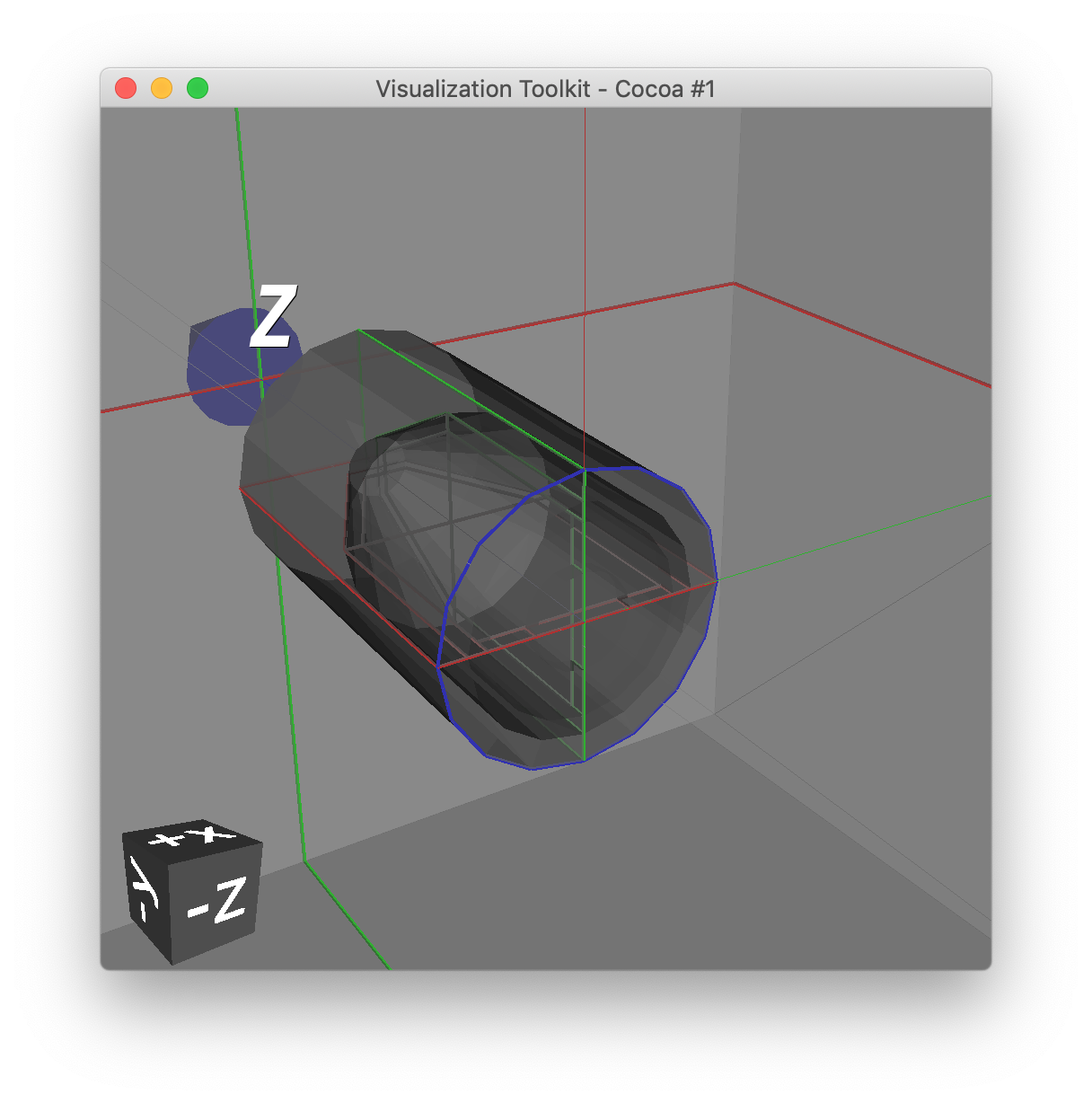Converting Geometry
Assembly Conversion
It is possible transform a logical volume into an assembly volume. This is useful in the case of two sources of geometry: placement of top level world logical volume solids will likely result in an overlap. This effectively removes the outermost logical volume but keeps the daughters. The produced assembly volume can then be placed or imprinted somewhere in the geometry.
An assembly cannot be used as an outermost ‘world’ volume for a geometry hierarchy.
Assuming lv is a pyg4ometry.geant4.LogicalVolume instance:
av = lv.assemblyVolume()
GDML to FLUKA
It is possible convert a pyg4ometry geometry to FLUKA. This is currently a work in
progress and not all Geant4-GDML constructions are implemented, although they can
be quickly added. Given a LV variable named logical
1import pyg4ometry
2reader = pyg4ometry.gdml.Reader("input.gdml")
3reg = reader.getRegistry()
4logical = reg.getWorldVolume()
5freg = pyg4ometry.convert.geant4Reg2FlukaReg(reg)
6w = pyg4ometry.fluka.Writer()
7w.addDetector(freg)
8w.write("FileName.inp")
If you want to load a file into Flair then a flair file can be written based on FileName.inp using the following
1 extent = logical.extent(includeBoundingSolid=True)
2 f = pyg4ometry.fluka.Flair("FileName.inp",extent)
3 f.write("FileName.flair")
Here is an example (viewed in Flair) of a simple Geant G4 solid that has been converted to FLUKA using this method


Note
All GDML placements are respected in the conversion from GDML to FLUKA, for both Placements and Boolean Solids. So for example a tree of LV-PV placements are reduced into a single transformation of a LV into a global coordinate space for FLUKA. A similar process is used for a tree of CSG operations.
Warning
Currently there are some things which are not implemented in the conversion. 1) Materials, 2) Scaled solids, 3) Reflections in placements, 4) Division, replica and parameterised placements. Some of these are straight forward to implement, like Materials and the non-Placement physical volumes can be done quickly if a user requires it.
FLUKA To GDML
FLUKA geometry can be converted to GDML using
pyg4ometry.convert.fluka2geant4. The conversion process is robust and
supports all FLUKA geometry constructs. Given a FLUKA file model.inp,
the following code can be used to translate it to a GDML file.
1import pyg4ometry.fluka as fluka
2import pyg4ometry.gdml as gdml
3from pyg4ometry.convert import fluka2Geant4
4
5# Read the FLUKA file, get the FlukaRegistry, convert the registry to a
6# Geant4 Registry
7reader = fluka.Reader("model.inp")
8flukaregistry = reader.flukaregistry
9geant4Registry = fluka2Geant4(flukaRegistry)
10
11worldLogicalVolume = geant4Registry.getWorldVolume()
12worldLogicalVolume.clipSolid()
13
14writer = gdml.Writer()
15writer.addDetector(geant4Registry)
16writer.write("model.gdml")
The core of this functionality is the translation of the FlukaRegistry instance into the equivalent Registry (i.e. Geant4) instance.
Here is an example of a model viewed in flair and the resulting visualisation in VTK of the Geant4 model


A number of keyword arguments are available to further modify the conversion. The fluka2Geant4 keyword arguments region and omitRegions allow the user to select a subset of the named regions to be translated.
The conversion of QUA bodies (fluka2geant4 kwarg quadricRegionAABBs) is complex and requires further explanation. In Pyg4ometry the mesh and GDML representations of FLUKA infinite circular cylinders, elliptical cylinders and half-spaces are all finite (but very large) cylinders, elliptical cylinders and boxes. This is robust as increasing the length of cylinders and depth/breadth of boxes does not increase the number of polygons used in the underlying mesh representation for that solid. However, this is not true of the quadric surface. A quadric surface cannot simply be generated to be “very large”, as the number of polygons will grow quickly, along with the memory consumption and facets in the resulting GDML TesselatedSolid, which will also slowing down tracking time in Geant4. For this reason the user must provide axis-aligned bounding boxes of the regions where any QUA bodies are present. It is recommended that these boxes be a centimetre larger than formally necessary to ensure a correct conversion. Providing the bounding box ensures that an efficient and accurate mesh of the QUA bodies can be generated meaning that the conversion to be performed in a tractable amount of time as well giving more performant tracking in Geant4.
CAD (STEP/IGES) To GDML
The conersion from CAD (STEP) to GDML uses OpenCascade to read, interrogate and tesselate the geometry. A CAD file might have a significant number of parts and assemblies. This naturally lends itself to the logical and physical volume structure of Geant4/GDML. Often the entire CAD file does not need to be converted, only a sub-assembly. To determine what the stucture of the CAD file is the following commands can be called, creation of a CAD reader and dumping to the terminal the structure of the CAD file.
r = _pyg4.pyoce.Reader("1_BasicSolids_Bodies.step")
r.shapeTool.Dump()
This particular example with have the following output
XCAFDoc_ShapeTool Trans. 0; Valid; ID = efd212ee-6dfd-11d4-b9c8-0060b0ee281b
PART COMPOUND 0:1:1:1 "1_BasicSolids_Bodies v2"
SOLID 0:1:1:1:1
SOLID 0:1:1:1:2
SOLID 0:1:1:1:3
SOLID 0:1:1:1:4
SOLID 0:1:1:1:5
Free Shapes: 1
PART COMPOUND 0:1:1:1 "1_BasicSolids_Bodies v2"
This example is 5 basic solids. So they are stored as a COMPOUND 0:1:1:1 and each SOLID is labelled 0:1:1:1:(1,2,3,4,5). Elements of the file do not need to have a name, it is more helpful to the user if they do. To convert a CAD model or a sub-assembly of a model the label is required. So a geant4 pyg4ometry registry can be created by calling.
reg = pyg4ometry.convert.oce2Geant4(r.shapeTool,"1_BasicSolids_Bodies v2")
It is also possible to call with the numerical tag, so
reg = pyg4ometry.convert.oce2Geant4(r.shapeTool,"0:1:1:1")
Either way of accessing a particular SOLID, COMPOUND or ASSEMBLY. Once created the registry can be written as described in the Exporting Geometry section. So putting it all together
r = _pyg4.pyoce.Reader("1_BasicSolids_Bodies.step")
reg = pyg4ometry.convert.oce2Geant4(r.shapeTool,"1_BasicSolids_Bodies v2")
w = p4gometry.gdml.Writer()
w.addDetector(reg)
w.write('1_BasicSolids_Bodies.gdml')